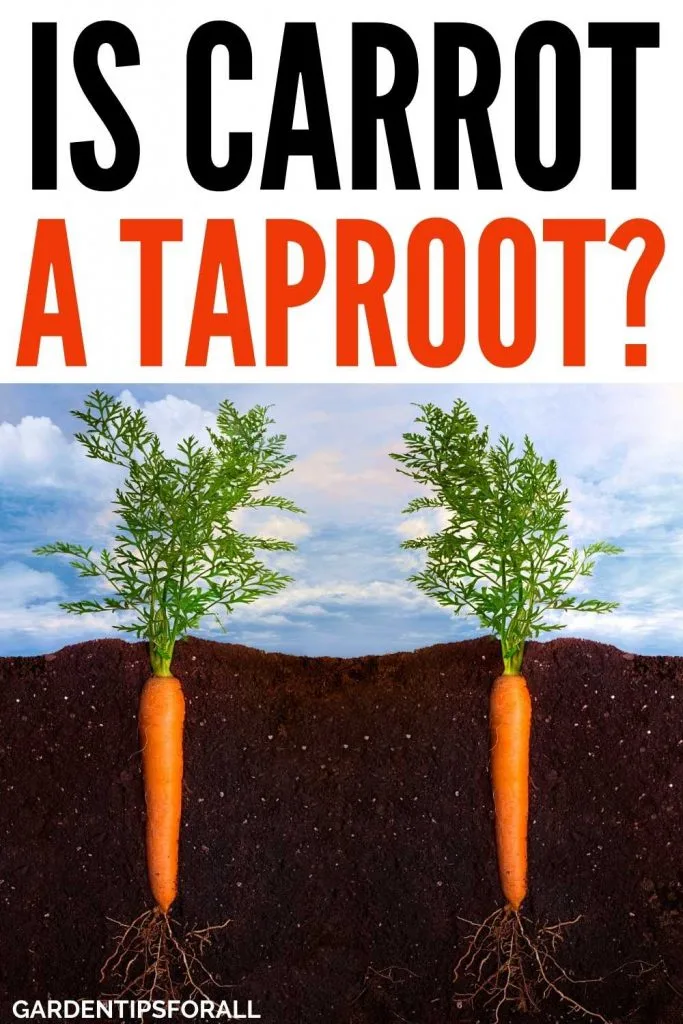Is Carrot a Taproot or Fibrous Root?
The carrot root is typically orange-colored (but other color pigments are available), with high water contents, starch, nutrients, and small amounts of essential oils.
But is carrot a taproot? Does carrot have a tap root or fibrous root?
Yes, a carrot is a taproot. The carrot plant has a conical-shaped primary root, with a wide top that narrows gradually toward the bottom, with secondary roots arising from the sides of the primary root. The root system fits the definition of a taproot and is the main consumed part of the carrot plant.

Now that you know the answer to the question, does carrot have a tap root or a fibrous root, keep reading to find out more about carrots.
The carrot (Daucus carota sativa) is a biennial crop planted from nursery-grown seedlings or sown directly in the garden. It’s a root vegetable first domesticated in Afghanistan around 900 AD. The plant requires loose soil, cool weather, and plenty of water to grow.
Related:
Characteristics of Taproots

Taproots are a primary root system in dicotyledonous plants. In this root system, a central primary dominant root forms from the radicle and grows downwards. Other secondary smaller roots grow on the taproot, and further tertiary roots grow from the secondary roots. This root system does well in loose and well-drained soils.
Taproots can stretch very deep to extremes of 75 feet in some desert plants and thus are able to reach water even in times of drought.
Taproots anchor the plant into the soil exceptionally well, ensuring the plant is stable and difficult to uproot.
In most cases, plants store products of photosynthesis in the form of starch and nutrients in taproots for use in droughts and when flowering as well as during seed production. Major types of taproots include:
- Conical Taproot: This taproot type has a cone shape. It has a wide circular top and gradually narrows in width toward the bottom. Carrot root is an example of a conical root.
- Fusiform Root: It has a vast middle and tapers off at each end. A good example is the root of radishes.
- Napiform Root: This type has a round top that sharply tapers toward the bottom. A good example is the turnip root system.
Factors that Affect Root Shape and Size

Many factors affect the shape and size of carrots and these include carrot genetics, soil type, soil preparation, plant spacing, temperatures, and the availability of nutrients.
Mainly, taproot length and width depend on the soil type and preparation. All factors held constant, carrots grown in loose, well drained, and highly nutritious soils are broader and more prolonged.
Also, plant spacing and density determine the room available for enlargement, and consequently, the root size.
Branching in carrots is mainly hereditary but can also occur due to under composted organic matter. Furthermore, injury to the root cap from growing into an obstacle or by insects may also result in branching.
When carrots grow in soils with high temperatures, the root surface becomes rough, and they’re shorter and thicker with strong flavor but less sugar.
The roots become slender and long when grown in temperatures between 13 and 200C. However, the harvest length and shape of the carrot principally form during the early phases of the plant development.
Common Pests and Diseases
Carrots’ most significant enemies are the carrot weevils and carrot rust fly. They lay eggs in the soil that hatch to larvae, which survive on carrot roots. Consequently, they lower the quality of the crop.
Also, nematodes and microscopic worms feed on and badly deform young carrot roots.
Other than the pests living in the soil, other animals such as deer, rabbits, and groundhogs dig up and eat young and mature carrots.
Carrots are affected by many diseases, such as Alternaria leaf blight, bacterial soft rot, and carrot yellow. Most of these diseases can destroy the whole crop, and you can do nothing much once plants are infected.
Prevention and Solution
As earlier stated, carrot diseases are notoriously annihilative and are best prevented than cured.
Keep a close watch on your plants, and uproot any infected crop. Also, you can use fungicides as a preventative measure. To further keep the diseases off your garden, clean up all debris after harvest, and do regular crop rotation.
For many soil-inhabiting pests, raising the soil temperatures through solarization kills the eggs and larvae.
You can as well use pesticides on the soil before planting. Also, crop rotation can significantly keep the pests at bay. If you notice larger animals are digging up the carrots, you can build a fence or use row covers.
Carrot Nutritional Value and Uses
Carrots has become part of popular meals and diets. To prepare them, scrub off dirt and wash thoroughly with water. Most people like to eat the whole carrot, but you can as well peel.
Then, you can slice, grate, or dice depending on the dish you’re preparing. Sliced carrots are delicious with hummus or yogurt-based dip, or just steamed, roasted, or boiled and served as a crunchy side dish.
Fresh, whole carrots can last for days unrefrigerated, but putting them in the crisper drawer of your fridge will extend their shelf life. It’s better to store them without the tops and in holed plastic bags.
A half-cup of fresh carrots has:
- 25 calories
- 6 grams of carbohydrates
- 2 grams of fiber
- 3 grams of sugar
- 0.5 grams of protein
- Vitamin A, K, and C
- Potassium, calcium, and fiber
What Type of Root is a Carrot? Taproot or Fibrous Root – Final Thoughts
So, is carrot a taproot? The answer is a big yes, carrot is one of the plants with taproots. The carrot plant has one primary root, which has secondary roots growing from its sides. Mainly, the root is the most consumed part of the carrot plant as it has numerous nutritious benefits. You can either plant the carrot seeds directly in the garden or in a nursery bed.
To keep diseases and pests away from your crop, take measures such as spraying pesticides and fungicides, fencing your garden, solarization, and covering the crops with row covers. Also, crop rotation could help a great deal.

